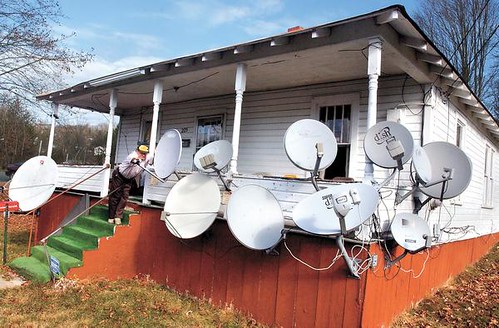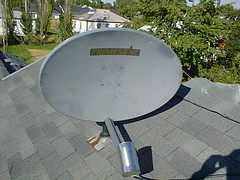For some satellite aficionados– or sat nuts– one dish is not enough.

The Register-Herald of Bethany, West Virginia reports how Al Jessup’s fascination with satellites changed his life– and his house:
Are 20 movie channels on demand just not enough?
Do constant reruns of “I Love the ’80s” on VH1 have you ready to gouge out your eyeballs?
Then come to Al Jessup’s house — where his 5,000-plus radio and television stations from around the world beamed in by his 12 satellite dishes are bound to keep you entertained somehow.
Since 1998, the Beckley resident has amassed a collection of 12 dishes around his James Street home. He said he first just began subscribing to Direct TV and Dish Network, but he later learned that by purchasing special satellite receivers he could receive “free to air” programming from several different satellites swirling the globe. The information on how to adjust a dish and set up a receiver to pick up programming from these stations such as Galaxy 10, AMC 2 and Telestar 5 is included with these receivers.
“Up in the sky, there’s lots of free stuff,” he said.
Over the years, the 54-year-old disabled former ice cream salesman collected more and more dishes so he could pick up more and more “free to air” channels. Neighbors, he said, never complained about his large display of dishes in front of his house. In fact, some of his dishes were hand-me-downs from his neighbors.
The last time he counted, he received more than 5,000 channels.
Read the entire article here.

 What do you do if you need to get WiFi access in a relatively remote location — say, a distant outbuilding? Waiting for WiMAX might mean waiting a long time in rural areas. Why not just grab an old Primestar dish, a tin can, and some coaxial cable, and rig up your own WiFi antenna?
What do you do if you need to get WiFi access in a relatively remote location — say, a distant outbuilding? Waiting for WiMAX might mean waiting a long time in rural areas. Why not just grab an old Primestar dish, a tin can, and some coaxial cable, and rig up your own WiFi antenna?
